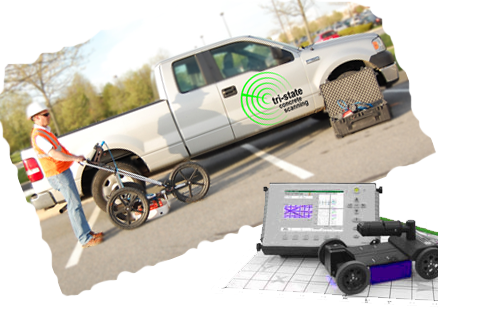Concrete Scanning: Your Guard Against Unforeseen Obstacles in Building Projects
In the realm of building, unforeseen obstacles can often interfere with timelines, budgets, and security protocols. However, with the advancement of concrete scanning technologies, the capability to expect and reduce prospective challenges has become an important element of job planning and execution. By using the power of innovative scanning approaches, building experts can proactively identify hidden hazards under the surface area, ensuring a smoother and more reliable job delivery. As we discover the value of concrete scanning as a protective shield versus unexpected obstacles in building and construction tasks, a much deeper understanding of its applications and advantages arises, dropping light on the transformative impact it can have on the industry in its entirety.
Significance of Concrete Scanning
Concrete scanning plays a vital role in making certain the security and honesty of building projects. By using innovative innovations such as ground-penetrating radar (GPR) and electro-magnetic induction, construction teams can accurately find rebar, post-tension wires, conduits, and various other possible obstructions within concrete structures. This process is essential for avoiding pricey damages, making sure architectural security, and maintaining project timelines.
One of the main reasons that concrete scanning is so important is its capacity to reduce dangers throughout the building stage. By determining surprise risks under the surface area, such as spaces or shabby areas within the concrete, service providers can proactively resolve these issues prior to they escalate right into even more significant problems. This aggressive method not only improves worker safety and security but also minimizes the chance of building and construction hold-ups and spending plan overruns.
Furthermore, concrete scanning allows building teams to make educated choices based upon accurate information. By having a clear understanding of the subsurface conditions, project managers can prepare excavation, boring, or cutting activities better, reducing the possibility for unintended damages to important structural elements. Ultimately, buying concrete scanning solutions is a positive measure that can conserve building and construction business time, money, and online reputation in the lengthy run.
Advanced Technologies for Detection

One more cutting-edge innovation is Electromagnetic Induction (EMI), which finds non-metallic and metal items underground by generating magnetic fields. EMI is particularly useful for situating buried utilities like cable televisions and pipelines - GPR Concrete Scanning Bellevue. In Addition, Acoustic Pulse Echo (APE) technology makes use of acoustic waves to assess the problem of concrete frameworks and discover delaminations, gaps, or cracks. APE gives real-time data, enabling instant decision-making on repair or support needs.
Moreover, improvements in infrared thermography have allowed the detection of moisture infiltration and insulation gaps within concrete structures. This innovation aids in protecting against future deterioration and making sure the durability of building and constructions. By incorporating these advanced technologies into concrete scanning practices, building and construction projects can mitigate risks and improve overall project results.
Benefits of Proactive Scanning
Implementing aggressive scanning methods in building projects boosts the very early detection of potential subsurface barriers, leading to enhanced job efficiency and price savings. By utilizing concrete scanning modern technologies such as ground-penetrating radar (GPR) and electromagnetic induction, construction groups can determine hidden dangers before they rise right into costly concerns.
By determining possible barriers early on, construction crews can take precautionary procedures to minimize threats and ensure a safer working environment for all included. In general, the positive technique to concrete scanning not only saves time and money but likewise enhances the general high quality and success of building jobs.
Enhancing Task Efficiency
To optimize construction job end results, the aggressive scanning approaches used not only enhance safety but additionally play an important function in enhancing overall job effectiveness. By carrying out extensive concrete scanning before commencing any kind of building and construction tasks, prospective obstacles and hazards under the surface area can be determined and reduced at an early stage. This proactive strategy lessens the possibility of costly hold-ups, remodel, and accidents, hence enhancing the project timeline and spending plan.
By preemptively attending to any kind of below ground complexities, the construction process can continue efficiently, with less disruptions and unexpected difficulties. Eventually, the combination of concrete scanning into building jobs not just ensures security and conformity yet additionally increases efficiency and job effectiveness.
Ensuring Safety And Security On-Site
Safety and security on construction sites is paramount to the success of any project. Guaranteeing security on-site needs a thorough strategy that entails aggressive actions to stop crashes and minimize threats. Among the crucial elements of advertising safety is providing adequate training to all personnel entailed in the task. Training must cover appropriate handling of equipment, adherence to safety methods, and emergency situation treatments. Normal security evaluations and audits ought to additionally be performed to determine prospective hazards and resolve them without delay.
Carrying out clear communication channels for reporting safety and security worries is vital for creating a risk-free work setting. Motivating a safety-first society where workers feel empowered to speak out regarding possible dangers can aid stop accidents prior to they occur. In addition, offering individual protective tools (PPE) and applying its usage is crucial in securing workers from damage.
Verdict

By including these sophisticated technologies right into concrete scanning methods, building jobs can mitigate go to website dangers and improve total job results.

In conclusion, concrete scanning plays a critical role in building projects by spotting unpredicted barriers that might potentially impede progress and concession safety on-site. GPR Concrete Scanning Bellevue.